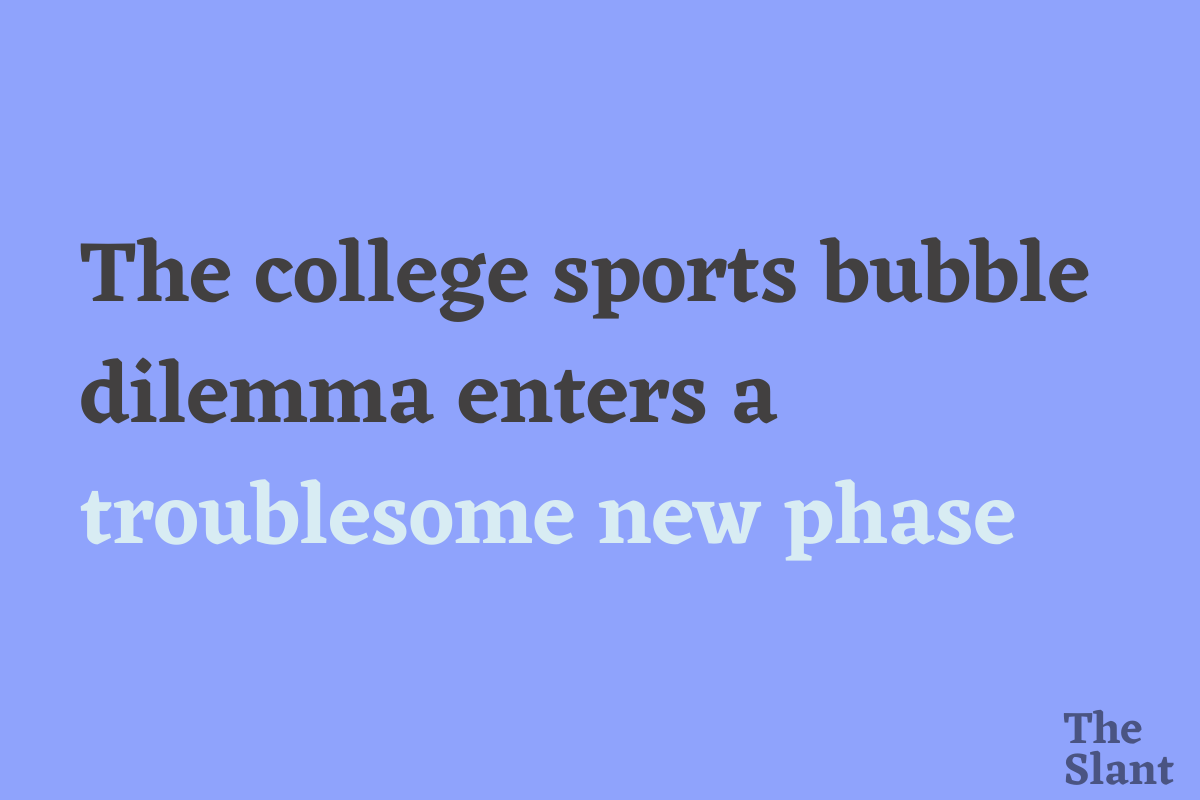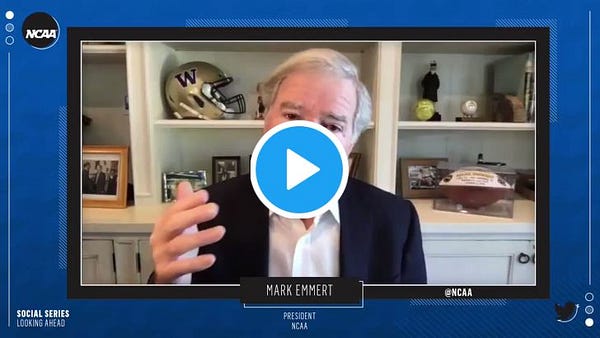The college sports bubble dilemma enters a troublesome new phase
Playing in a bubble would seem to violate the concept of amateurism. But college football and basketball could be headed that way.
Welcome! Before we get started, a plea to follow along on Instagram here.

There are a few roadblocks to holding a fall sports season in college athletics in 2020. You may have heard about them. But, as detailed earlier this week, many conferences are, as of now, saying they’re going to try anyway.
With four of the 10 FBS conferences postponing fall sports until at least the spring, that leaves six leagues out here still making a Hail Mary attempt at football: the SEC, ACC, Big 12, Sun Belt, Conference USA and the American Athletic Conference. While conferences have put out different explanations for why they’re pushing ahead with fall sports in the face of the Covid-19 pandemic, a snippet from comments by Dr. Catherine O’Neal, an LSU infectious disease expert and advisor to the SEC, is about to seem especially relevant to all:
“So we feel confident in our plan,” she told The Athletic last week. “I think our football teams can absolutely get through this. I think our athletic departments can absolutely get through this. I worry about our community and outside forces that we can’t control.”
(emphasis mine)
This is because colleges around the country have started welcoming back non-athlete students to campus. Infections are already sprouting up. At North Carolina, administrators have already canceled in-person classes for the rest of the fall semester and temporarily suspended athletics. According to the Daily Tar Heel, “UNC confirmed 135 new cases of COVID-19 between Aug. 10 and Aug. 16, 130 students and five employees.” Tasneem Nashrulla and Emerson Malone report at BuzzFeed News:
The timing of Monday’s email wasn’t ideal. In less than two hours after it was sent, the deadline would pass for receiving a 95% refund for fall tuition. After that, students would only get 80% back. In an email to BuzzFeed News, the university did not provide any update about whether tuitions would be fully refunded.
“I definitely feel it was unfair for UNC to unload this info right before tuition was due,” one 20-year-old statistics student, who asked to remain anonymous, told BuzzFeed News. “It made it seem like a highly calculated maneuver, a cash grab if you will.”
On Tuesday, Notre Dame halted classes for at least the next 14 days after 146 students and a staff member tested positive for the coronavirus, and school leadership said students will be sent home for the remainder of the semester if things don’t improve. Sports are suspended for at least 48 hours. Allie Kirkman reports at The South Bend Tribune on how things quickly unraveled once students arrived:
Students partied. Others didn’t follow safety protocols. Cases immediately spiked. And the university wasn’t ready for the outbreak. Some students reported that calls to the university’s COVID hotline went unanswered. Many complained about waiting days to get tested on campus. Others relayed stories about a lack of preparation at quarantine areas the university had set up. Some professors were outraged they weren’t notified that students in their classes had tested positive.
As Kirkman notes, “In May, the president of the University of Notre Dame, the Rev. John Jenkins, insisted that despite a growing number of coronavirus cases locally and across the country, it was “worth the risk” to bring students back to campus for the fall.”
The thing that can save college sports from campus outbreaks goes against the biggest lie the industry perpetuates.
Bubbles. They’re what saved the NWSL, NBA, WNBA and MLS seasons, and they’re what could save college sports, or at least football, the industry’s cash cow. The above professional leagues succeeded because they quarantined everyone, put them in the same location and, at least to some extent, bubble-wrapped them. Once athletes got to the bubble location, that’s where they stayed. Athletes had little to no contact with the outside world once they crossed into the bubble. And while each league took a different approach to its bubble, all four approaches worked. Once everyone passed the quarantine period, positive tests just about ceased. It might take a Herculean effort, but a bubble could make a season possible for any league that wants to put in the work.
"Even with not going to classrooms, that helps us create a better seal around our program and a better bubble," North Carolina head football coach Mac Brown told reporters this week. "The NBA model's working. They've had very few distractions and that's what we're trying to do is make sure that our players and our staff understand that we've got three months here where we cannot go outside for social reasons or to eat or anything else if we want to have our season."
The problem with a college sports bubble, though? The industry’s insistence on clinging to the concept of amateurism. The NCAA and all of our favorite schools that make up its membership have gone to great lengths to ensure athletes are not legally considered employees and thus are not entitled to a salary as compensation for their participation in sports. Rather, its leaders contend these are just regular students who choose to play a sport, so payment in college credits and a few other perks is sufficient. Creating a bubble to save the college football season would be all sorts of problematic. Pro sports are happening because of a mutual agreement: athletes negotiated conditions they found acceptable to play in exchange for a salary while owners wanted to make sure their gigantic investments didn’t go belly-up. A college bubble would involve college athletes choosing to play because they want to further their NFL Draft hopes or just because they “love the game” while industry leaders continue to make millions. Not only would players not be getting paid while in the bubble, they’d have to take classes on top of all the athletic work they do and if they don’t get sufficient grades while putting in 50+ hours of work a week, they’d risk violating academic eligibility rules for next season. And, as Sam Khan Jr. and David Hale point out at ESPN, the very idea of a bubble would appear to violate NCAA rules:
The reason college football teams -- or any other sport -- can't create their own bubble is because the NCAA doesn't allow it. Rule 16.5.1 in the NCAA Division I manual says schools are "required to apply the same housing policies to student-athletes as it applies to the student body in general" and prohibits athletic dorms, which it defines as those with "at least 50 percent of the residents [who are] student-athletes."
A college sports bubble would violate the lie that makes up the ground on which the NCAA has built its multi-billion dollar mansion. And it would do so at a time when athletes are just starting to realize the amount of power they do have.
Bubbles aren’t just getting attention as a temporary fall sports fix, and it’s not just coaches supporting the idea.
College basketball needs a bubble. NCAA leadership has already admitted this.
When I say the NCAA admitted it needs bubbles to survive, I don’t mean a junior NCAA employee was caught on tape saying the organization knows it needs bubbles. I mean the NCAA president literally said this out loud and on purpose in a taped interview.


“If we modify the model, shrink the bracket sizes, do everything in predetermined sites instead of running kids around the country, use predetermined sites, move toward bubbles or semi-bubble models in volleyball or soccer, there’s a way to do it,” NCAA president Mark Emmert says in the above video, the entirety of which can be found here. “Will it be normal? Of course not. You’ll be playing a fall sport in the spring. Will it create other challenges? Of course. But is it doable? Yeah. It is doable and we want to do that. We want to, again, make it work for these students.”
Emmert doesn’t appear to be advocating for entire-sport bubbles here, just for tournament bubbles. That would get around his comments in May that you can’t have college sports without students on campus, as well as circumventing the housing rule ESPN documented. And while Emmert is talking about fall sports in that exact snippet, it seems clear this thought extends to basketball. Here’s NCAA Senior Vice President of Basketball Dan Gavitt, talking last week about the 2021 NCAA men’s basketball tournament:
"Our first and primary goal and preference is to have the tournament on the dates that are set, at the venues that are pre-determined, but if the virus necessitates a different path, we will adjust accordingly.”
The NCAA is advocating for the thing that would serve its bottom line. While it doesn’t oversee football’s enormously financially successful postseason, the NCAA does have a gigantic financial stake in March Madness.
"We're the thing that the NCAA is most concerned about because men's college basketball and the tournament pays for something like ... it produces 98% or more of the money for the NCAA," Duke men’s basketball coach Mike Krzyzewski told ESPN radio this week (transcription via Scott Gleeson at USA Today).
Bubble talk isn’t going to end here. There is reportedly already support for an early-season bubble tournament in Orlando, the site where the NBA is currently holding its restart. That might not seem too different from the sport’s usual early-season tournaments. But holding one during a pandemic and pretending athletes don’t deserve a cut of the money they’re generating while most other students aren’t even allowed on campus would brazenly violate the concept of amateurism in a way I previously figured (maybe naively) the industry’s leaders wouldn’t.
Thanks for reading! If you like what you see here, tell a friend and follow along on IG.

